Asus P4S800D-E Deluxe & Gigabyte 8S655TX Ultra: SiS 655TX Challenges Intel's Best
by Wesley Fink on December 9, 2003 1:52 PM EST- Posted in
- Motherboards
Gigabyte 8S655TX Ultra: Features and Board Layout
Like Asus, Gigabyte adds a number of additional features to make the 8S655TX uniquely Gigabyte.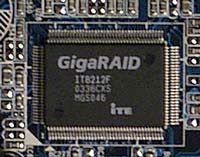
Gigabyte has used the additional ITE GigaRaid on many of their top boards, and it is included on the 655TX. The GigaRaid chip adds the capability of using 4 additional IDE drives in a RAID configuration or as regular drives. This does mean you will need to install both SiS and GigaRaid drivers if you plan to use both features.
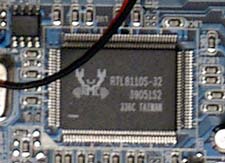
The Realtek Gigabit chip is used for the on-board LAN connection on the 8S655TX.

The high quality Realtek ALC658 audio codec is showing up on many top-end boards. The features of the AC'97 2.3 compatible six-channel audio CODEC are top-notch for an on-board audio solution. They include six 20-bit DAC channels, two pairs of stereo 18-bit ADC, and a 100dB S/N ratio. More information on the features and specifications of ALC658 is available at Realtek.
If you have Dolby digital capabilities, SPDIF outputs are provided by coaxial and optical jacks on an included accessory bracket. Two additional mini jacks are also provided so 6-channel powered speakers can be used and you can still have a MIC jack.
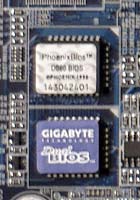
Gigabyte usually reserves their trademark Dual Bios feature for top-end boards, and yet, it is included on the 8S655TX Ultra. Even though this board will sell for around $100, it is loaded with top-end features and options. The only major Gigabyte feature not seen here is the accessory 6-phase power module that is found on some other top Gigabyte motherboards.

I/O port offerings on the 8S655TX Ultra include the PS2 ports, Parallel, 2 Serial, 4 USB 2.0 ports, Gigabit LAN, and 3 audio mini jacks. SPDIF connections and 2 additional mini jacks are on an included accessory bracket. There are no firewire ports on the rear I/O panel, but both standard and mini Firewire ports and 2 additional USB 2.0 ports can be added on the other included accessory bracket.
Board Layout
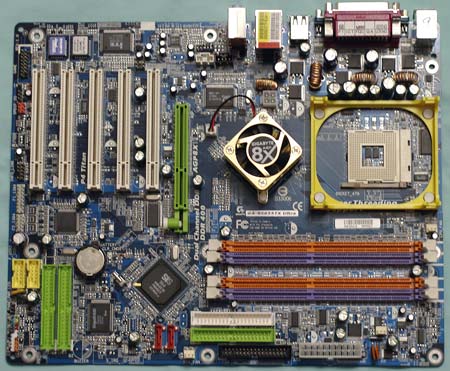
The Gigabyte 8S655TX Ultra is also a well-laid out, full-size ATX design. Our only complaint is the location of the 12V connector. Otherwise, the board layout is really excellent. While the 20-pin ATX connector is in our preferred upper right position, the 4-pin 12 volt connector is to the left of the CPU socket and near the midline of the board, just like the Asus P4S800D-E. We will probably have to go back to SiS with this complaint, since it is likely carried over from the Reference design. The on-board audio connectors are about left midline and above the AGP/PCI slots, making audio connection easy in almost any case design or board setup. Even the floppy connector is above midline and behind the DIMM slots, making that connection easy for almost any build.
The IDE connectors, IDE RAID, and 2 SATA connectors are all in acceptable locations. The 8S655TX Ultra has an excellent layout no matter how you look at it.
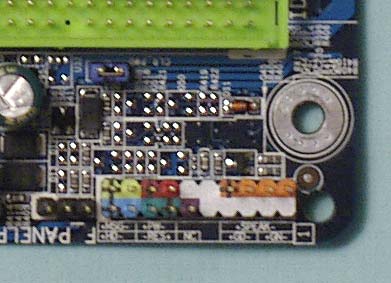
Gigabyte was the first manufacturer to use color-coded panel connectors, and they have extended this feature to almost all their current boards. We are glad to see it used on the 8S655TX Ultra, as it really does make it easier to figure out the panel connections.










24 Comments
View All Comments
FFS - Wednesday, December 10, 2003 - link
Q? to Wesley does these mobos have control of CPU fan speed (again like MSI Neo2), so it run more slow with low CPU load (= more silent)?Another one is how it's compatible with Radeon 9700 Pro? F.e. My SIS648 even with latest SIS-AGP drivers have have a conflict with Hercules R9700Pro when Fast Write is turned on...
Competition is G R E A T E thing,... but you know we also want stability :))) So far, as I know Intel chipsets before were far more stable and compatible with other hardware...
The bottom line "as fast" does not always mean "as good"... :(( And since I also love competition let's hope that SIS655TX as good as 875P.
ripdude - Wednesday, December 10, 2003 - link
A good article on a serie of good boards, I'm very happy you took the P4C800-E dlx in the test.I'm more then happy with the increased competition these boards bring, the P4C800-e dlx is still about 199 in euro land.
SmoiL - Wednesday, December 10, 2003 - link
When is the Asus P4S800D-E coming out? Nada on pricewatchWesley Fink - Wednesday, December 10, 2003 - link
Several of the cells in the Feature Table on page 3 were reversed and have now been corrected.Dual Channel (2x64 bit) is called 128 bit mode on the SiS. The BIOS has the option to run 128-bit (Dual-Channel) mode or to force Dual 64-bit.
FFS - Tuesday, December 9, 2003 - link
Also, as I remember VIA VT6307 support 3 (not 2) 1394a FireWire ports (as on MSI Neo boards), so why Gigabyte would cut them to 2 ???And besides Wesley always trying to stress out color-coded panel connectors.
For me it's more important that you can change RAM without taking off videocard and ASUS had such problems with some of their mobos (now it looks better... but talking about overclocking ... hmmmm.
Even it's damn stable: heatsink on ASUS SiS 655TX is passive (already -) and too close to CPU (plus wrong orientation - same mistake as with original
P4C800 Deluxe. So - NO oversized cooler for CPU on this board.
FFS - Tuesday, December 9, 2003 - link
Realtek ALC658 codec AC '97 2.36-Channel with UAJ Shoud go to Gigabyte and vice versa...
Oh well.., I had my SIS648 for a while and .. so now I'd rather prefer to pay eXtra for board with Intel chipset :((
Plus Gigabit LAN will work faster(=better) with CSA...
FFS - Tuesday, December 9, 2003 - link
Hey guys... In the features table on-board audio codecs are mixed up :)Shalmanese - Tuesday, December 9, 2003 - link
Er, I don't think Sis supports 33Mhz Memory speeds... (pg 5) ;).What happened to the tech support turnaround time bit? That was always the favourite part of your reviews.
Tokelil - Tuesday, December 9, 2003 - link
On page 3 it says its the Gigabyte MB that uses the Marvel Gigabit controller, while on page 4 it says its the asus board that uses the Marvel controller... My guess is it is Asus that uses it and its wrong on page 3.FishTankX - Tuesday, December 9, 2003 - link
What on earth is the difference?There is no commercially avaliable 128 bit DDRSDRAM. All DDRSDRAM is 64 bit.